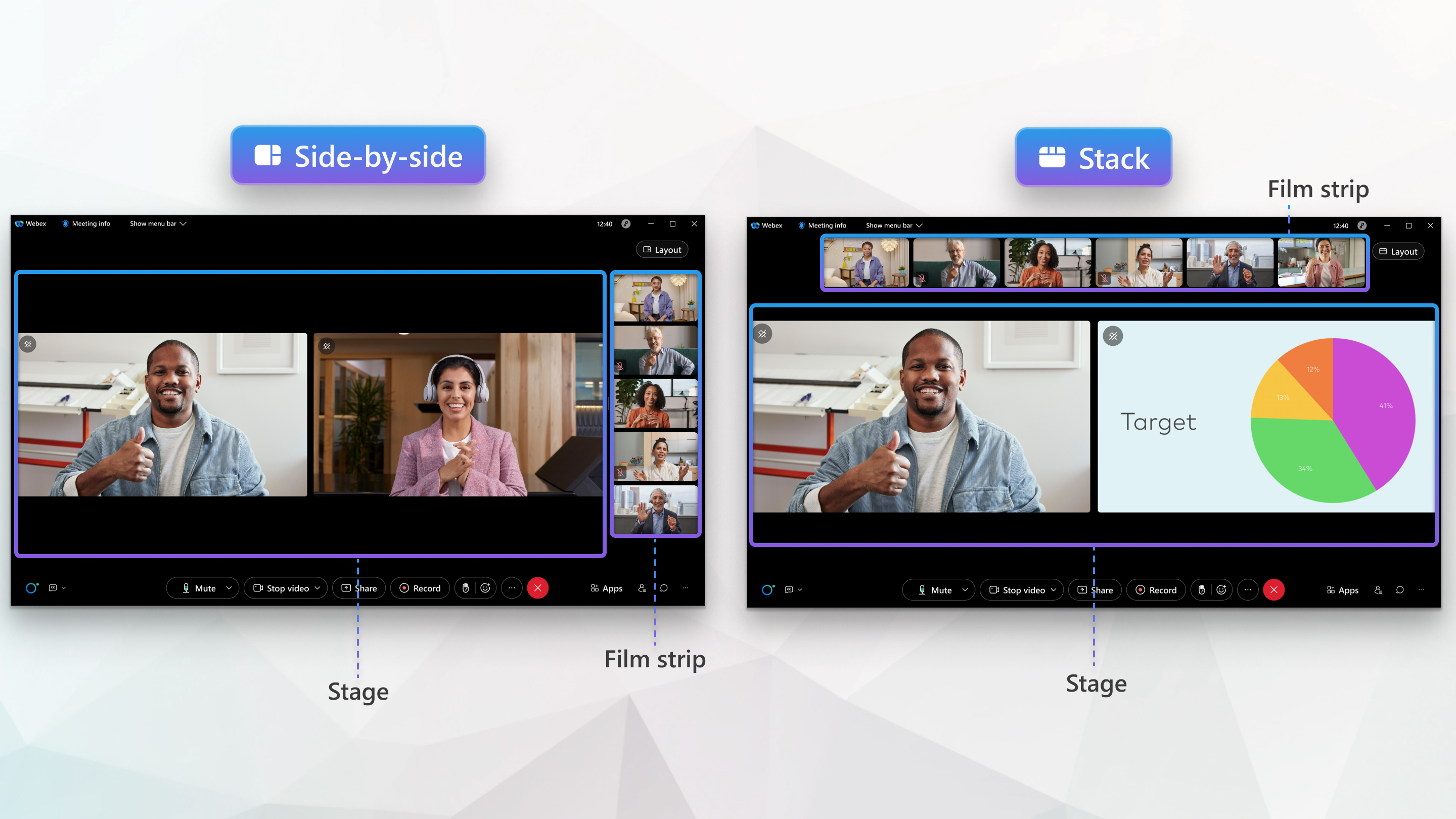- Home
- /
- Article

Video layouts in meetings and webinars
 In this article
In this article Feedback?
Feedback?Use the available video layout options and views to focus on the people and content in the meeting that’s important to you. Check out what you can do to customize your layout as a meeting host, cohost, or attendee.

You have several ways that you can set and customize your video layout. Your video layout options depend on the device you use to connect to the meeting or webinar, how many people attend, and whether anyone shares content. There are advantages to using each of the available video layout options and you can customize your layout at any time.
These video layout options don't apply to webinars in webcast view.
The layout option doesn't appear in meetings with fewer than two participants, or webinars with fewer than two panelists.
For more information about the maximum capacity for meetings, webinars, and events, see What is the maximum number of participants in a Webex session or call?
Video layout settings
There are ways you can customize your layout that can help you better follow what's going on in your meeting or webinar. Want to make sure you know everyone's name? Set them to always appear. Want to see only those who share their video? Hide anyone who doesn't share their video.
To learn more about the ways you can adjust some of your layout settings, see the following articles:
Switch your video layout view
There are different video layout views that you can use to focus on the content that's important to you. The device you use to join the meeting determines which of the views you can choose.
When you use the Meetings desktop or web app, you can choose from the following views:
-
Grid view—useful when you want to divide your attention across a lot of speakers in a large meeting.
-
Stack view—useful when you want to see other participants appear above the active speaker or shared content.
-
Side by side view—useful when you want to see participants appear next to the active speaker or shared content.
-
Full-screen view—useful when you want to float panels and scale them freely, or drag them to another monitor.
To learn how to set the view that you want, see Switch your view Webex Meetings, Webex Webinars, and Webex Events (classic).
When you use the iOS or Android app, you can choose from the following views:
-
Grid view—Useful when you want to divide your attention across a lot of speakers in a large meeting.
-
Equal view—Useful for one-on-one conversations or small meetings with only a few others.
-
Stack view—Useful when you want to focus on the active speaker or shared content but also want to see other participants.
-
Focus view—Useful for when you want to see the active speaker or shared content full-screen.
To learn how to set the view that you want, see Switch your view in Webex Meetings from a mobile device.
Adjust grid view
Grid view gives you the ability to set how many participants that can appear on-screen at any given time. You can show as many as 25 participants on a page or even just one. You can view more participants by changing the page you're viewing.
To learn more, see Adjust how many participants appear in grid view in meetings, webinars, and events.
Stage views

The stage is a customizable area that allows you to focus on the content in a meeting or
webinar. By default, the stage shows the active speaker or shared content. Up to six other
participants appear outside in the filmstrip. The stage is available when you select Stack
view or Side by side view from the Layout menu in the desktop or web app.
menu in the desktop or web app.
Customize the stage
You can further customize your stage to suit your needs. For more information on how you can customize your stage, see the following articles:
Sync your stage
If you're a host or cohost of a meeting or webinar, you can control what appears on the stage for all participants by syncing it. Syncing your stage makes sure that everyone who sees the stage has the same content. Any changes you make to your stage update in real-time.
To learn more, see Sync your stage with everyone in Webex Meetings, Webex Webinars, and Webex Events (classic).
Known issues and limitations
-
Participants who join a meeting or webinar using an iPhone or Android phone can see only the content in the left panel of a synced stage.
-
Video devices can receive synced stage layouts but do not support the ability to customize what is shown on the stage.
- RoomOS 11 devices do not support stage sync. Instead, they continue to use their own layouts as they currently have.
- On-premise-registered video devices can receive stage layouts. When content is
shared:
- Single-screen devices show a filmstrip of participants above the content.
- Dual-screen devices show the stage on one screen and content on the other.
- Dual-screen devices will only show stage participants on one screen, and the other screen remains blank unless content is being shared.
-
The web app supports up to six videos in grid view (maximum 180p resolution).
-
Synced stages don't appear for participants who join an event using the web app in Events (classic).
-
Synced stages don't appear for participants who join a meeting using Meetings web app.


